About 40-80% of people complain that the spine in the lumbar region hurts, but no more than 25% of them seek medical help. In fact, such unpleasant sensations can be caused both by relatively harmless reasons and by pathological changes in the spine. Therefore, you should not treat them with contempt.
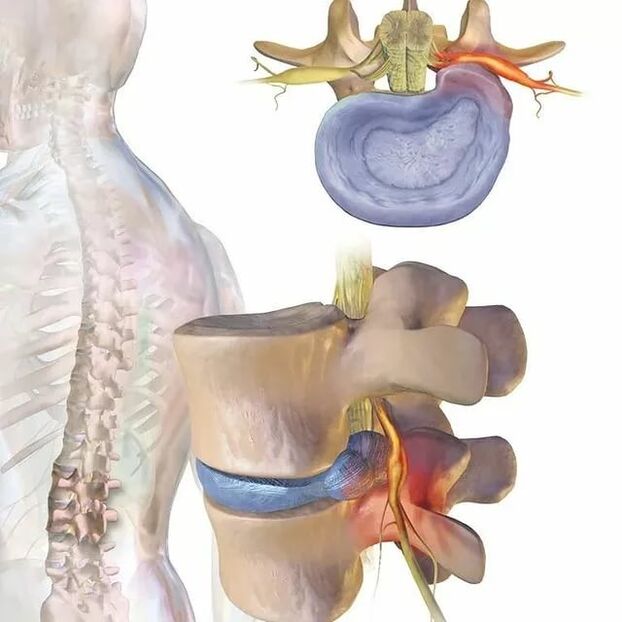
Causes of back pain
The spine consists of a whole complex of structural elements: bones, joints, intervertebral discs, ligaments, nerves. Changes in each of them can be associated with painful sensations and of a different nature. In addition, the spine is surrounded by paravertebral muscles, pain in which patients often confuse with pain in the spine. Thus, the causes of pain can be numerous. This can be overwork, a natural restructuring of the body during pregnancy, etc. But if the pain appears regularly, it is worth contacting a vertebrologist or neurologist, as often the fact that the spine hurts systematically in the lumbar region indicates the development of some diseases. .
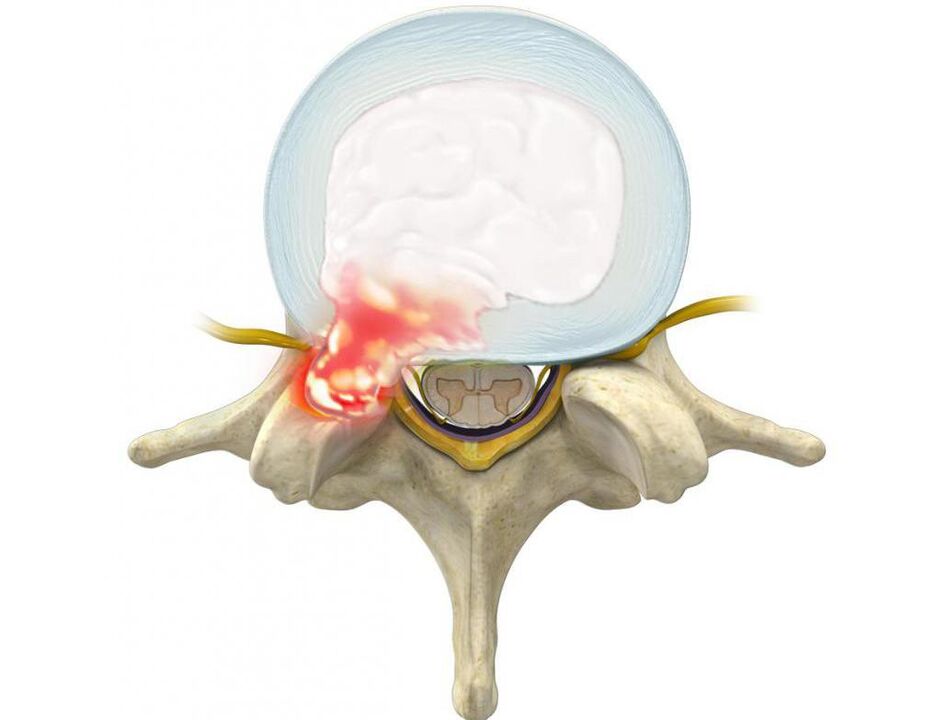
Most often, in such situations, patients are diagnosed with:
- intervertebral disc pathology (reduction of disc height, elongation, intervertebral hernia, disc);
- aspect joint pathologies (spondyloarthritis, joint cysts);
- Inflammatory diseases (ankylosing spondylitis or ankylosing spondylitis, reactive arthritis, psoriatic arthritis)
- compressive vertebral fracture against the background of osteoporosis;
- neoplastic lesions of the spine.
Pathologies of the intervertebral discs
Degenerative changes in intervertebral discs or osteochondrosis are very common, especially among young and middle-aged people. This is mainly due to the need to stay seated for a long time or engage in heavy physical work. In old age, the disc dries out and the vertebrae grow together.
Already in the initial stages of the onset of degenerative changes in the intervertebral discs, which are cartilage of a special configuration separating the vertebral bodies, back pain may appear. This is due to irritation of the pain receptors of the outer layers of the disc as well as the posterior longitudinal ligament of the spine. Often, osteochondrosis provokes an aseptic inflammatory process, which leads to a reflex segmental muscle spasm. As a result, pain in the spine increases, and there are also limitations in mobility.
Osteochondrosis tends to progress steadily, especially in the absence of proper treatment and lifestyle correction. It then leads to the formation of extensions, and later to intervertebral hernias, which provoke the worsening of existing symptoms and the appearance of new ones.
The lumbar region is most often affected, due to the fact that it carries the highest loads in daily activities.
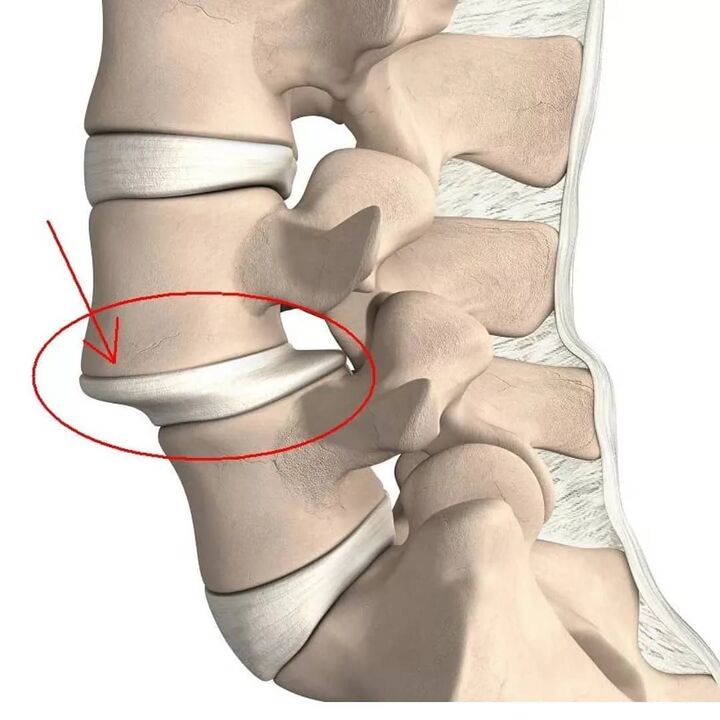
Creeps are extensions of the disc while maintaining the integrity of its outer layer, called the annulus fibrosus. By maintaining the influence of provocative factors over time, the fibers of the annulus fibrosus do not withstand the load and pressure of the inner contents of the disc (nucleus pulposus) and rupture. As a result, the nucleus goes beyond the physiological position of the intervertebral disc. At the same time, the spine in the lumbar region always aches or the pain radiates to the legs and the discomfort increases with sudden movements, bending, lifting heavy objects, straining, coughing, sneezing, laughing, as well as with prolonged sitting. a position, standing, standing.
Often, patients with extensions and hernias already formed subconsciously take a forced stand, leaning slightly toward the healthy side. In this case, the pain in the spine in the lumbar region can reach high intensity, depriving a person of the ability to work. In such cases, he is forced to adhere to bed rest and to relieve the pain, he squeezes the bent leg and bring it to the stomach.
Most often, extensions and hernias form in the direction of the spinal canal, into which the spinal cord (cauda equina) and the nerve roots that branch from it pass. The latter pass through natural holes in the vertebral bodies and further branch into the lumbar plexus, which is responsible for innervating the lower extremities and various organs (including the genitals).
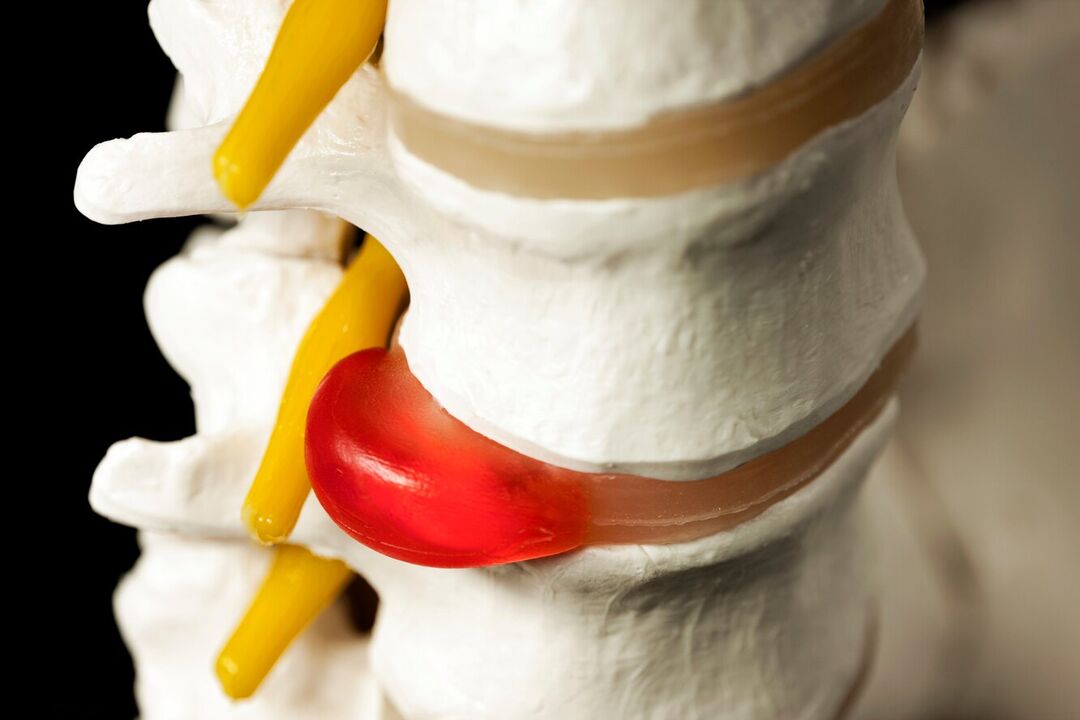
Therefore, often with long-term osteochondrosis, the formation of hernias in the lumbar region, the pain in the spine gradually not only intensifies, but also is complemented by other disorders. If a deformed disc or swollen soft tissue as a result of the inflammatory process squeezes the spinal root that passes near them, neurological disorders occur. Therefore, pain in the spine in the lumbar region can be complemented by radiating to the buttocks, groin, front, inside, outside the thigh, lower leg and foot. It depends on what kind of nerve root will be damaged, i. e. at the level at which the segment of spinal movement pathological changes will be observed. Also, in the relevant areas of the lower extremities, sensory disorders in the form of feelings of crawling, numbness, changes in temperature sensitivity, pain, tactile stimuli, and limited mobility may be observed.
Changes in the height and functionality of the discs that arise in osteochondrosis and its complications lead to damage to the articular apparatus of the spine, as well as degeneration of the vertebral bodies themselves. The consequence of this is the development of spondylosis, ie calcification of the anterior longitudinal ligament and the formation of bone-cartilage growths on the surface of the vertebral bodies (osteophytes). They can not only damage the surrounding tissue and squeeze the spinal roots, causing severe pain in the spine, but also grow together. As a result, adjacent vertebral bodies combine into a single whole, which significantly limits mobility in the lower back.
Osteochondrosis can be associated with reactive changes in the vertebral bodies, in particular, reactive aseptic spondylitis, leading to osteosclerosis. This is accompanied by compression of bone tissue and dramatically increases the likelihood of vertebral fractures.
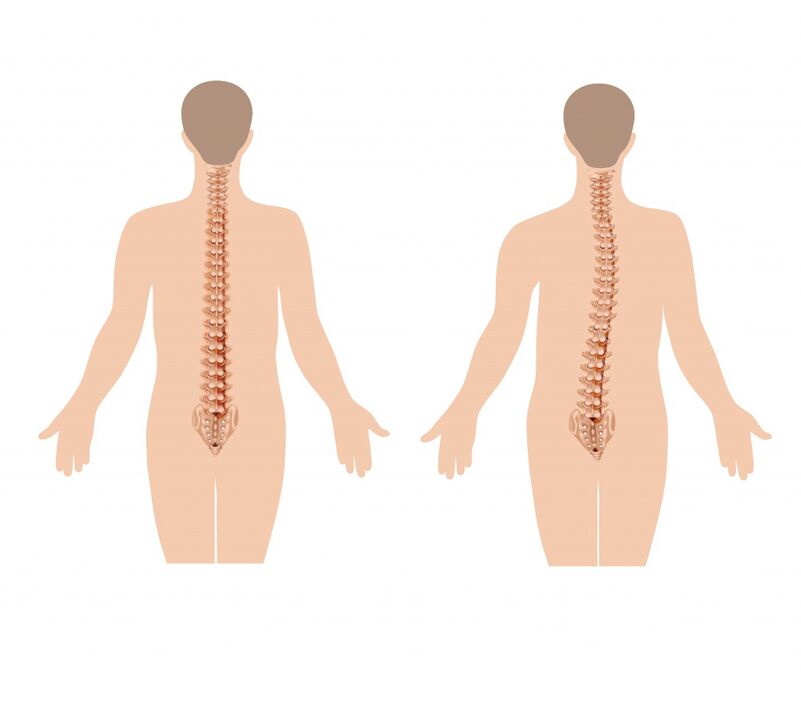
Diseases of the site joints
Pathologies of the aspect joints or lumbar joints, especially their arthrosis, can also cause back pain in the lumbar region, including severe pain. Although most often the pain is painful and localized deep inside. Their appearance is due to the fact that their synovial capsule is very innervated. In such situations, the pain usually focuses directly on the affected area and tends to increase with bending, stretching, turning the body, prolonged standing. Walking and sitting help reduce their stiffness. But in some cases, pain can also be given in the area of the hips, coccyx, as well as in the back and outside of the thighs.
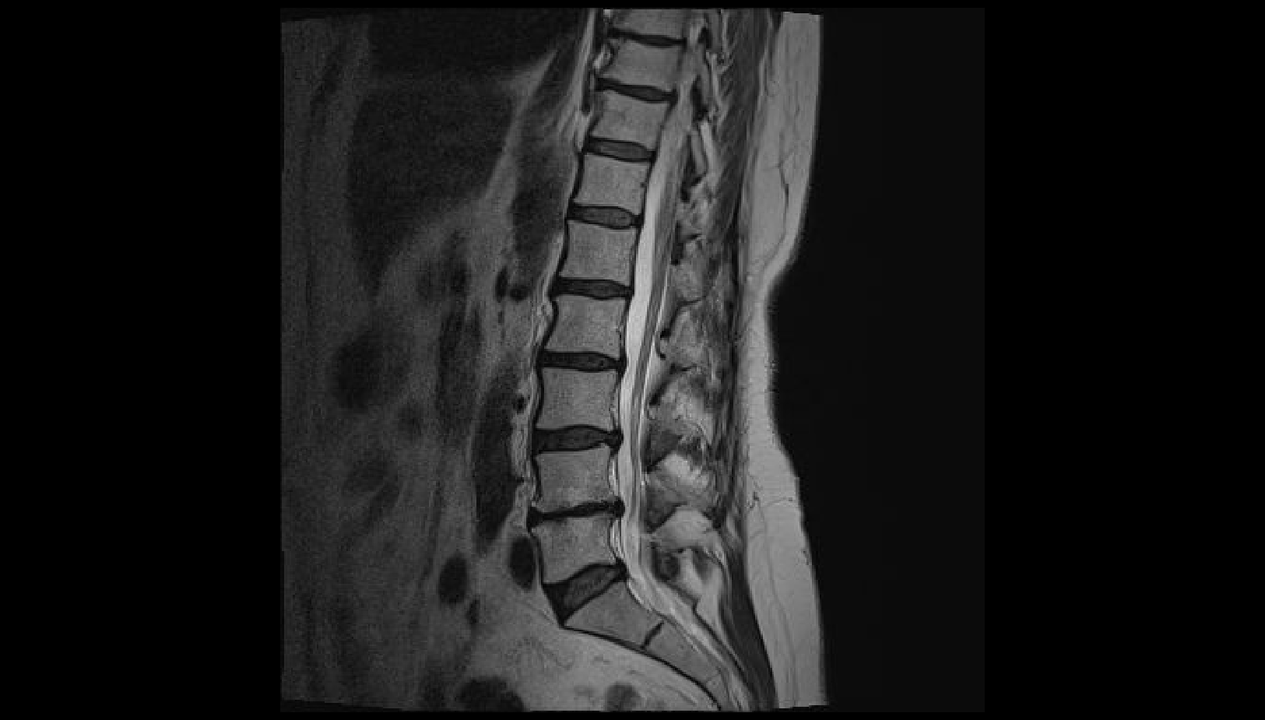
Inflammatory diseases of the spine
Inflammatory diseases of the spine are less common than pathologies of the intervertebral discs and joints of the joints. However, they also damage the spine. This includes:
- ankylosing spondylitis or ankylosing spondylitis;
- reactive arthritis;
- psoriatic arthritis etc.
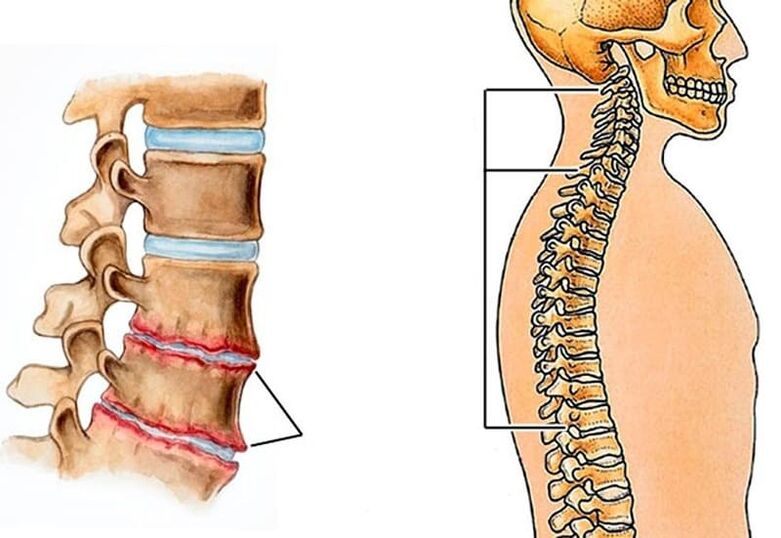
The symptoms of these diseases usually appear before the age of 40 and most often at the age of 20. This distinguishes them from degenerative-dystrophic pathologies of the discs and joints of the spine, which often develop after 40 years. In this case, the pain is characterized by a gradual increase in intensity. Moreover, their severity decreases after physical exercise, but does not decrease at rest. Therefore, in inflammatory diseases, the spine in the lumbar region often aches at night and especially strongly in the morning, immediately after sleep.
The most difficult situation is observed with ankylosing spondylitis, and it is the one that most often than other inflammatory diseases affects the lumbar region. This term implies inflammation of the intervertebral joints with their subsequent immobilization due to the formation of a dense bony, cartilaginous or fibrous fusion between the articular bone structures.
It is initially characterized by mild back pain, but over time they gradually spread higher, covering the thoracic spine and then the cervix. This is associated with the development of spinal mobility restriction in all planes, as the spine, as a result of the changes that occur, appears to have sunk into a specific case. It was also noted:
- extension of the lumbar lordosis (natural curvature of the spine in the lumbar region);
- deterioration of the thoracic kyphosis, which provokes flexion;
- reflex tension of the back muscles;
- progressive deterioration of mobility restriction due to involvement of the site nodes in the pathological process and ossification of the intervertebral discs;
- morning stiffness for an hour or so.
Inflammation of the iris (iritis), cornea (keratitis), mucosa (conjunctivitis), iris and ciliary body of the occiput (iridocycle) is observed in 10-50% of patients.
The progression of ankylosing spondylitis leads to the fact that an increasing number of joints in the pathological process. As a result, patients are forced to take the so-called prayer pose. Means pronounced kyphosis of the thoracic spine, tilt of the upper body down, bending of the knees with a sharp restriction of range of motion in the chest, which affects the depth of breathing.
The rate of disease progression depends on the appropriateness and completeness of treatment.
Compressive vertebral fracture
The compression fracture is the flattening of the vertebral body, as a result of which it becomes wedge-shaped. This leads to disruption of the anatomy of the spine, can provoke trauma to the spinal cord and its roots, as well as become a driving factor for the rapid progression of degenerative-dystrophic changes.
The middle vertebrae 1 and 2 are more susceptible to injury, as they receive the greatest axial load.
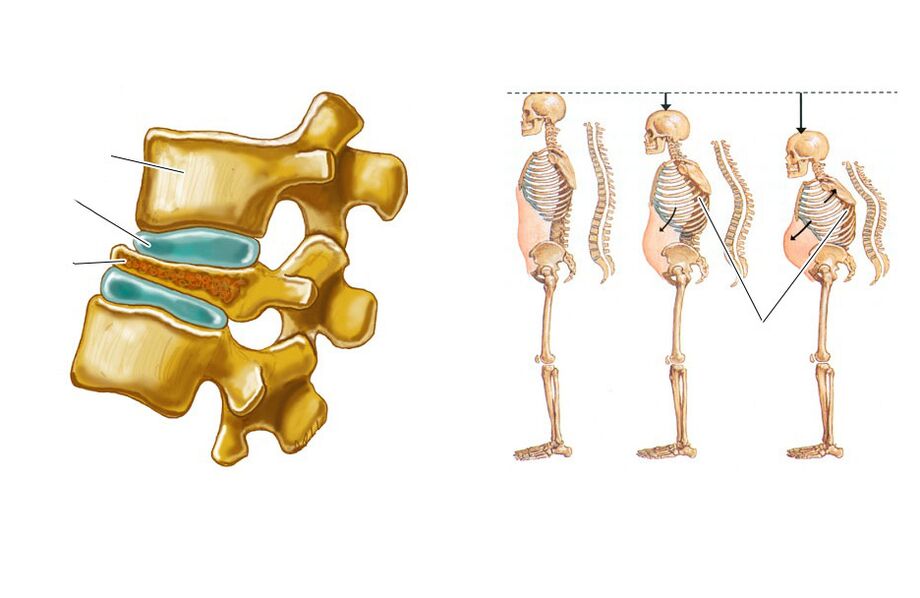
Spinal compression fractures often occur in the elderly due to the development of osteoporosis, d. m. th. , reducing bone density. In such cases, not only a slight fall, but also lifting weights, an unsuccessful movement, may suffice to be injured.
The pathology is characterized by the presence of pain in the spine, which restricts movement, increases with lowering, movement, and attempts to raise a straight leg up. It usually lasts 1-2 weeks and then gradually decreases over 2-3 months. In some cases, there is radiation of pain in the ridges of the iliac bones and hips. A decrease in the height of a broken vertebra provokes an increase in lumbar lordosis, which also contributes to the appearance of painful sensations.
If a fracture is not diagnosed in a timely manner, a decrease in vertebral height leads to behavioral changes, a decrease in growth. This provokes reflex tension and contraction of the spinal muscles, which causes chronic back pain and requires long rest.
Spinal neoplastic lesions
Neoplastic lesions of the spine imply the formation of benign and malignant tumors in it, as well as metastases, the source of which are neoplasms of other organs. This is much less common than pathologies of intervertebral discs, ankle sprains, ankylosing spondylitis and even compressive fractures, i. e. only in 1-2% of patients with back pain. But such lesions require diagnosis and treatment as early as possible.
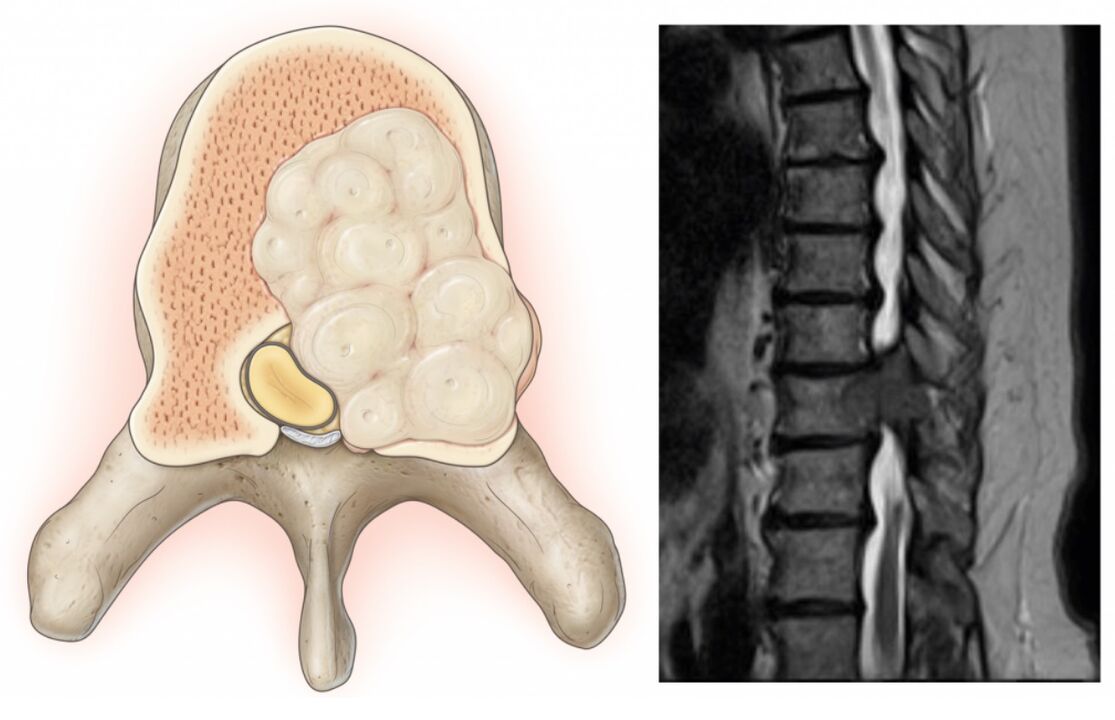
The characteristic features of neoplastic lesions of the spine, in addition to pain in it, are:
- an increase in body temperature, including up to subfebrile values;
- unreasonable weight loss;
- inability to find a comfortable body position;
- the presence of pain at night;
- severe pain in the spine;
- inability to relieve pain with conventional analgesics.
Even if you have 1 or 2 of these symptoms, you should make an appointment with your doctor right away.
Similarly, the following may appear:
- Chondroma is a malignant tumor diagnosed in 20% of patients with spinal cancer lesions. Most often it forms in the sacrum and can occur in people of any age and gender.
- Young sarcoma - occurs in 8% of patients with neoplastic lesions of the spine. Most common in young people.
- Chondrosarcoma is a malignant neoplasm, which accounts for 7-12% of cases. Most often found in middle-aged men.
- Aneurysmal bone cyst is a benign neoplasm.
- Hemangioma is a benign vascular tumor that is present in 11% of people. It may not be detected throughout a person's life. But it increases the risk of vertebral fractures.
- Metastases of other tumors are secondary malignant neoplasms. Most often, cancers of the breast, prostate, lung, and less commonly kidney, thyroid gland, and skin metastasize to the spine.
Diagnosing
If the spine in the lumbar region hurts, it is worth making an appointment with a neurologist or vertebrologist. At the meeting, the doctor first collects a medical history, asking questions about the nature of the pain, the circumstances of its occurrence, the duration of its continuation, the presence of other symptoms, lifestyle, etc.
The specialist then performs an examination. In his framework, he not only palpates the spine, determines the localization of pain, evaluates the gait and posture that the patient takes unconsciously, but also performs functional tests. With their help, you can detect signs of ankylosing spondylitis, neurological deficit, assess the degree of mobility of the spine and get other diagnostic data.
Based on this, the doctor can already assume the possible causes of the pain syndrome. Instrumental and sometimes laboratory diagnostic methods are also described to clarify them, as well as to accurately determine the extent of the damage. Most often they use help:
- radiographs in frontal and lateral projection, sometimes with functional radiological tests;
- CT - allows better visualization of bone structures, therefore, is more often used to diagnose spondylosis, fractures, bone tumors, etc. ;
- MRI - makes it possible to scrupulously assess the condition of cartilaginous structures and soft tissues, so it is often used to diagnose osteochondrosis, extensions, intervertebral hernias, spinal cord lesions, etc. ;
- electromyography - indicated for neurological disorders of unknown origin, as well as for assessing the degree of nerve damage;
- radioisotope bone scintigraphy - used to diagnose malignant tumors and metastases;
- X-ray densitometry is the best method for diagnosing osteoporosis;
- myelography - used to detect signs of compression of the spinal cord and nerves of the cauda equina.
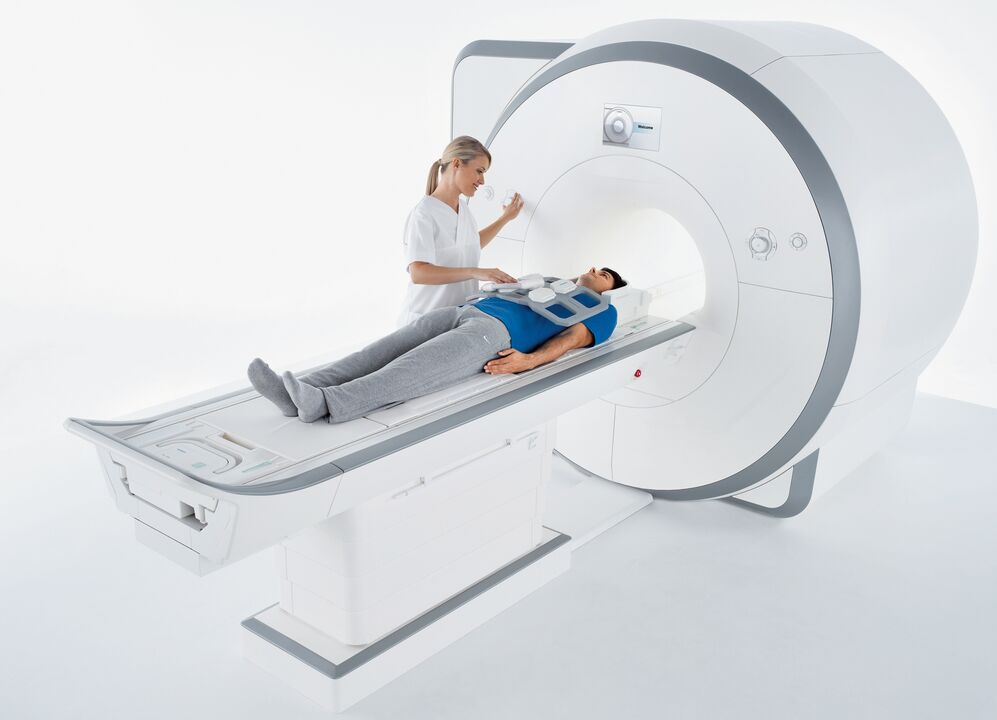
Treatment
For each patient, treatment is chosen strictly on an individual basis and not only on the basis of the diagnosis, but also of the nature of the existing concomitant pathologies. However, it is the cause of the back pain that determines the therapy tactics. It can be conservative or involve surgery.
But the first step is always to direct efforts to relieve the pain, especially if it is severe. For this, patients are prescribed NSAIDs, antispasmodics, painkillers. And in severe cases spinal blockages are performed - anesthetic injections and corticosteroids at specific points of the spine.
Bed rest is not indicated for all patients. And with intervertebral disc pathologies, it may be completely contraindicated, as a decrease in physical activity contributes to the conversion of acute back pain into chronic one.
Exclusively conservative or non-surgical treatment is prescribed for:
- osteochondrosis;
- ankylosing spondylitis;
- osteoarthritis of the facial joints;
- fractures with slight compression.
It is usually complex and consists of:
- drug therapy, which may include NSAIDs, chondroprotectors, muscle relaxants, immunosuppressants, corticosteroids,
- physiotherapy (UHF, magnetotherapy, laser therapy, traction therapy, etc. );
- Exercise therapy;
- manual therapy.

If the cause of back pain are intervertebral hernias, extensions, spondylosis, severe vertebral fractures, tumors, surgery is often indicated. It is also necessary for:
- ineffectiveness of conservative therapy for degenerative-dystrophic changes;
- an increase in neurological deficit;
- spinal motion segment instability;
- development of complications, in particular spinal canal stenosis.
Most modern spine surgeries are minimally invasive. Thanks to this, intraoperative and postoperative risks are significantly reduced, the rehabilitation period is shortened and facilitated, and the effectiveness is not inferior to more traumatic open surgeries. Depending on the disease detected, it may be recommended:
- Discectomy is an operation indicated primarily for hernias and protrusions, especially those provoking cauda equina syndrome. It can be performed using microsurgical instruments through a 3 cm incision (microdiscectomy) and using endoscopic equipment supplied to the spine through punctures about 1 cm in diameter (endoscopic discectomy). When the intervertebral disc is completely removed, it is usually replaced with implants.
- Vertebroplasty and kyphoplasty - indicated for compressive vertebral fractures, hemangiomas and some other diseases. The essence of the operation is the injection of bone cement that hardens rapidly through a thin cannula into the vertebral body, which strengthens it. With kyphoplasty, it is also possible to restore the normal dimensions of the vertebral body, which is important in the event of a serious drop in their height as a result of a fracture.
- Fixation surgeries are used to stabilize the spine. Metal structures of various natures are used for this, which usually remain in the patient's body for the rest of his life.
Thus, the spine in the lumbar region can hurt for a variety of reasons. Therefore, with the prolonged persistence of painful sensations, their regular appearance, the increase of pain over time and even more the addition of other symptoms, it is necessary to contact a vertebrologist or neurologist. Early diagnosis will make it possible to detect pathological changes in stages when it is easier to cope with them and if the disease is not completely cured, then at least stop its progression and maintain a high standard of living.












































